Pietro Rancanelli, who probably came from Perugia, is known from only one painting: a panel in Montefalco (see below) that he signed as “Petrus Ranchanellus” in 1602. Francesco Federico Mancini (referenced below) has shown on stylistic grounds that he was almost certainly the “Maestro Pietro” who was documented in 1592 as an associate of Silla Piccinini at San Pietro. Professor Mancini suggests that both men worked here under Giovanni Battista Lombardelli; that they followed him to Assisi to work on the decoration of Cappella Coli Pontani in Santa Maria degli Angeli; and that they subsequently worked together Palazzo Bonucci Baldeschi, Perugia.
Perugia
Frescoes in San Pietro (1592)
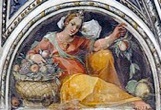
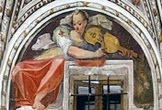
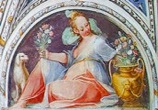
As noted above, Pietro Rancanelli was probably the “Maestro Pietro” who was documented in 1592 as an associate of Silla Piccinini at San Pietro. The frescoes in the church that are attributed to him include those of allegorical figures in five lunettes on each side of the crossing (which include the three of those on the right that are illustrated here).
Frescoes in Palazzo Baldeschi Bonucci (late 16th century)
The frescoes of the Sala dei Legisti of Palazzo Baldeschi Bonucci, which are attributed to Silla Piccinini and Pietro Rancanelli, were commissioned after the death in 1567 of Filippo Baldeschi, the jurist who had built the palace and who had used this room to teach law. The scenes include depictions of 19 prominent jurists from the Baldeschi family, including Filippo himself and his most illustrious ancestor, Baldo degli Ubaldi. There is an image of some of the frescoes in the website of the Fondazione Orintia Carletti Bonucci, the current owners of the palace.
Annunciation (late 16th century)
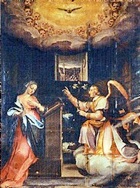
Assisi
Frescoes in Santa Maria degli Angeli (late 16th century)
As noted above, Francesco Federico Mancini (referenced below) has suggested that Pietro Rancanelli worked on the decoration of Cappella dell’ Annunciazione in Santa Maria degli Angeli from the middle of 1592. This chapel belonged to the Perugian widow Laura Coli Pontani, who had already commissioned the altarpiece for its altar from Federico Barocci. Specifically, frescoes of three figures in the chapel are attributed to Pietro Rancanelli: St John the Evangelist; St Matthew; and the personification of Faith.
Montefalco
Madonna and Child with saints (1602)
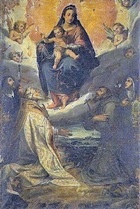
The composition of the panel is based on that of Raphael’s Madonna di Foligno (1511-2), which was at this time on the high altar of Sant’ Anna, the church of a Franciscan nunnery in Foligno.
Read more:
F. Mancini, “Un Documento per Federico Barocci e la Cappella Coli Pontani in Santa Maria degli Angeli” Esercizi, 6 (1983) pp 18-47
C. Galassi, “ Pietro Rancanelli”
in A. Ambrosini Masari et al. (Eds), “Nel Segno di Barocci: Allievi e Seguaci tra Marche, Umbria, Siena” (2005) Milan pp 334-7
Return to Art in: Assisi Montefalco Perugia.



